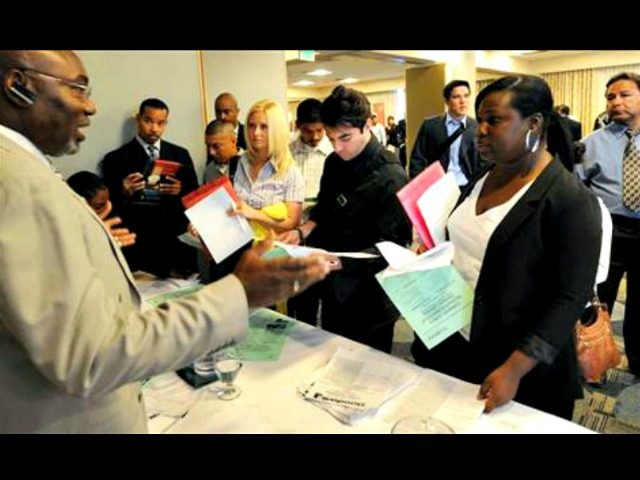President Trump on Tuesday suggested, again, increasing legal immigration levels beyond an already historically high rate that would pit more foreign competition against American workers and further depress U.S. wages.
During a meeting at the White House, Trump said he wanted “more people” coming to the U.S. than the already more than 1.2 million legal immigrants admitted every year to take American jobs that would otherwise go to citizens.
Trump said:
Speaking of jobs, we have to have more people coming into our country because our real number is about 3.6, 3.7. It took a little blip up during the shutdown and went up to 4. And 4 — any country would take a 4. But we’re about 3.7; probably going lower. We need people. So we want to have people come into our country, but we want to have them come in through a merit system, and we want to have them come in legally. And that’s going to be happening. We’re doing very well in that regard. [Emphasis added]
Trump has repeatedly claimed over the last month that there are not enough American workers for all the jobs his administration has helped create across the country. The “labor shortage” talking point is often used by the big business lobby, outsourcing firms, and Silicon Valley elites who prefer importing low-wage foreign workers to take U.S. jobs rather than recruiting disenfranchised Americans.
The sentiment for increasing legal immigration is a break from the president’s commitment to reduce overall immigration levels — a promise he made in 2015, 2016, and 2017.
Trump was once so supportive of reducing the current unfettered foreign labor competition that American workers have been subjected to through legal immigration levels that he pledged to halt all immigration until the country was at full employment.
“Before any new green cards are issued to foreign workers abroad, there will be a pause where employers will have to hire from the domestic pool of unemployed immigrant and native workers,” Trump’s 2015 immigration policy papers stated.
Trump’s claim that the current labor market needs “more people” is not backed up by Bureau of Labor Statistics data, which reveals that there are at least 13 million working-age Americans who are either unemployed, not in the labor force but want a job, or who are working part-time jobs but want a good-paying full-time job.
Increased Legal Immigration Subjects 13M Americans to More Foreign Competitionhttps://t.co/iomP4zA7Ei
— John Binder 👽 (@JxhnBinder) February 8, 2019
Out of those 13 million Americans who are available for U.S. jobs, about 6.5 million are unemployed. Of those unemployed, close to 13 percent are American teenagers who are ready for entry-level U.S. jobs — the exact jobs that low-skilled foreign workers generally tend to take.
About 1.6 million Americans are not in the labor force at all, but they want a job, including about 426,000 discouraged American workers who are demoralized by their job prospects. Also, there are 5.1 million Americans who are working part-time jobs but who want full-time jobs. More than 1.4 million of these U.S. part-time workers said they had looked for full-time jobs but could not find any.
Trump’s suggestion to increase legal immigration levels would not only diminish the job prospects of millions of Americans but also depress their wages.
Every one percent increase in the immigrant composition of an American workers’ occupation reduces their weekly wages by about 0.5 percent, researcher Steven Camarotta has found. This means the average native-born American worker today has their weekly wages reduced by perhaps 8.5 percent because of current legal immigration levels.
In a state like Florida, where immigrants make up about 25.4 percent of the labor force, American workers have their weekly wages reduced by perhaps more than 12.5 percent. In California, where immigrants make up 34 percent of the labor force, American workers’ weekly wages are reduced by potentially 17 percent.
Likewise, every one percent increase in the immigrant composition of low-skilled U.S. occupations reduces wages by about 0.8 percent. Should 15 percent of low-skilled jobs be held by foreign-born workers, it would reduce the wages of native-born American workers by perhaps 12 percent.
Those benefitting from increasing legal immigration levels are corporate executives, Wall Street, real estate investors, big business, and multinational conglomerates that would enjoy a flooded labor market with reduced wages, more workers, added residents who need housing, and additional consumers to buy their products.
The mass importation of legal immigrants — mostly due to President George H.W. Bush’s Immigration Act of 1990, which expanded legal immigration levels — diminishes job opportunities for the roughly four million young American graduates who enter the workforce every year wanting good-paying jobs.
In the last decade alone, the U.S. admitted ten million legal immigrants, forcing American workers to compete against a growing population of low-wage foreign workers. Meanwhile, if legal immigration continues, there will be 69 million foreign-born residents living in the U.S. by 2060. This would represent an unprecedented electoral gain for the Left, as Democrats win about 90 percent of congressional districts where the foreign-born population exceeds the national average.
John Binder is a reporter for Breitbart News. Follow him on Twitter at @JxhnBinder.

COMMENTS
Please let us know if you're having issues with commenting.